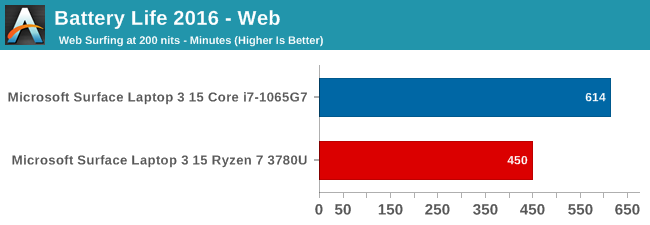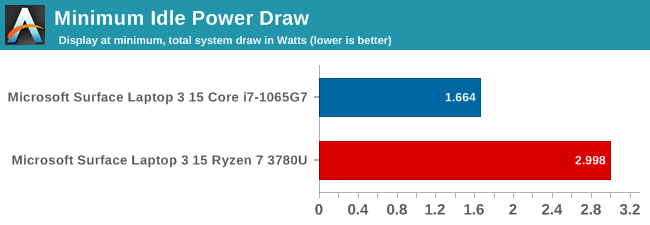The Microsoft Surface Laptop 3 Showdown: AMD's Ryzen Picasso vs. Intel's Ice Lake
by Brett Howse & Andrei Frumusanu on December 13, 2019 8:30 AM ESTPlatform Power
Performance aside, the other side of the coin is battery life. AMD made big gains in battery life with the Ryzen 3000 series, somewhat addressing the power requirements of the platform and getting rid of some of the excessive idle power draw, but they are still using DDR4 on their mobile platform, which puts them at a disadvantage right out of the gate. Intel has made very good gains in battery life over the last several generations, and the move to 10 nm for Ice Lake also brought along LPDDR4X support. Most of the previous generation laptops stuck with LPDDR3, unless the manufacturer needed more than 16 GB of RAM, where they’d be forced to switch to DDR4. Finally adding LPDDR4X support is something that Intel has needed to do for a while, and ironically Intel’s flagship Core product line lagged behind their low-cost Atom lineup which did support LPDDR4.
Web Battery Life

The Ryzen 7 3780U powered Surface Laptop 3 was slightly under the Ryzen 5 device we tested at launch, but still in the same range. The AMD system isn’t helped very much by Microsoft only offering a 46 Wh nominal battery capacity, which is rather undersized for a 15-inch laptop. The Ice Lake device, as we’ve seen before, was much more efficient under load, offering a sizeable battery life lead.
Idle Power
One of AMD’s biggest challenges was to get their laptop SoC into a premium device, and with the Surface Laptop 3 they have succeeded. Microsoft has shown themselves as being adept at squeezing battery life out of devices, with low-power displays, and good internal components to minimize power draw. Here Intel has held a considerable advantage over the last couple of years, and the move to 10 nm should, in theory, help as well.
To test the idle power draw of both systems, the battery discharge rate was monitored with the screens fixed in at 5.35 nits, to minimize the power draw of the display on the result. Normally we’d prefer to have the display completely off for this test, but Microsoft’s power plan on the Surface Laptop actively turns off the laptop when the display times out.

The Ice Lake system was able to go all the way down to right around 2 Watts of power draw – and sometimes slightly under – with as low as 1.7 Watts seen. We’ve seen under 1 Watt of draw on an 8th generation Core Y series processor, and around 1.5 Watts on the same generation U series, so considering the display is not completely off on the Surface Laptop, the 2-Watt draw is quite reasonable.
The Picasso system was not quite as efficient, drawing 3 Watts at idle. This is in-line with the results we’ve seen on other Picasso systems and explains the lower battery life results on the AMD system. AMD made big gains moving from Raven Ridge to Picasso, but I’m sure the team is looking forward to the 7 nm Zen 2 coming to their laptops, which we hope will address this further.










174 Comments
View All Comments
MBarton - Monday, December 30, 2019 - link
Agreed. Even the outlook for 2020 server ICL has vanished from Intel's presentations. If they can't get working server parts out, there definitely won't be a 10nm desktop part in 2020.deil - Monday, December 16, 2019 - link
I just wonder why...16 GB Dual-Channel DDR4-2400 16 GB Dual-Channel LPDDR4X-3733
AMD gains A LOT from faster ram, what they get? cheappest....
Brett Howse - Monday, December 16, 2019 - link
That's all that Picasso supportseastcoast_pete - Wednesday, December 18, 2019 - link
That is why I am more upset with AMD not putting their best foot forward on mobile. A mobile APU based on Zen2 in 7 nm with Navi-based graphics and an LPDDR4 or LPDDR5 capable memory controller would have given Intel's Ice Lake a real challenge. Instead, AMD is a full generation behind. Ironic, as it's the other way around for desktops.MBarton - Monday, December 30, 2019 - link
Why would a cash-strapped AMD "put their best foot forward" in the mobile segment. It's the lowest profit market of the three. They need profit margins and server/HEDT are FAR more profitable than mobile.MutualCore - Monday, December 16, 2019 - link
Why nothing about SSD performance? This is a critical point for people that need to copy large amounts of data.derstef - Wednesday, December 18, 2019 - link
"DDR4-2400" vs "LPDDR4X-3733" ... fair comparision on the GPU side of things? I dont think so.Butterfish - Friday, December 20, 2019 - link
Your argument is irrelevant. Both are using the best possible RAM they supported. It is AMD’s fault to recycle old chip with outdated spec. We are comparing mobile platform (laptop), not desktop. Everything is highly integrated with CPU influences GPU performance. As both laptops are house in the same cooling solution it is a fair comparison to see which platform is faster in various task.maroon1 - Sunday, January 12, 2020 - link
AMD does not support LPDDR4XAnsley11 - Wednesday, December 18, 2019 - link
$2000, you've got to be kidding me! Why would anyone waste there money on these? I can get a $1000 desktop then can blow these away, and get a couple hundred dollar tablet to do the tablet stuff. Heck, I could probably get both for under $1000 if I shop around and am smart with my choices. People waste FAR too much money on unnecessary tech.